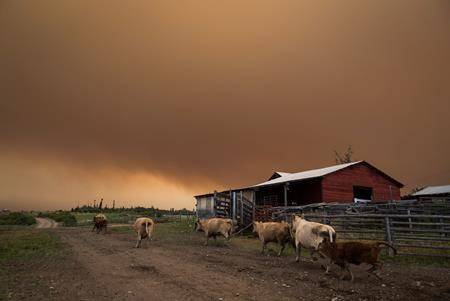Thick smoke blanketing B.C. communities far from any flames — including Vancouver where the haze Monday obscured the city’s mountain views — could be particularly harmful for children and seniors but anyone with poor health should take precautions, says a senior scientist.
Sarah Henderson of the B.C. Centre for Disease Control said children’s lungs don’t fully develop until about age 10 and are therefore more sensitive so it’s best for them to stay indoors when air quality is poor. Elderly people may be more affected by smoke because lung function decreases with age, she said.
“You can’t hold as much air in your lungs, that’s the natural part of the aging process, but it means the smoke might have more effect on you than a healthy younger person, especially if you happen to have some chronic disease,” Henderson said.
“We’re concerned about anybody with any kind of pre-existing condition — MS, diabetes, cancer, heart disease, and definitely respiratory diseases,” she said Monday, when the sky over parts of B.C. were a hazy grey.
READ MORE: Smoky skies bulletin issued for most of B.C.
An air quality health index released by the B.C. government rated conditions as 10-plus, or at very high risk, in areas including Castlegar, Whistler, Nanaimo, Parksville and parts of the Fraser Valley, the Okanagan and Metro Vancouver.
On the weekend, two trialthlons were cancelled because of thick smoke in the central Okanagan.
Dr. Trevor Corneil, chief medical officer for Interior Health, the Okanagan’s provincial health-care co-ordinator, said Sunday even professional triathletes could struggle if particulate entered their lungs and bloodstream.
“Elite athletes will face difficulties breathing, some early exhaustion, and in extreme cases if they’re also dehydrated, they may experience confusion from difficulty breathing the air,” Corneil said.
The Wildfire Service said the smoke in the Kamloops Fire Centre made it difficult to see new fires on the weekend and limited its use of aircraft to fight the blazes.
It’s the second summer in a row when air quality has been affected in B.C. by wildfires.
Small particles breathed in from the fires are interpreted as foreign invaders by the body, the same as a bacterium or a virus, Henderson said, adding it mounts an attack, or an immunological response, which leads to inflammation.
Pregnant women should also take precautions because exposure to smoke can cause lower birth weights, likely leading to long-term problems, she said in an interview.
“Infants have very sensitive lungs when they’re born so the smoke is going to be even worse for them and depending on the level of exposure, there might be damage done to infant lungs, which might have lifelong implications.”
Henderson suggested using portable air cleaners indoors to keep the air as clean as possible during smoky conditions.
The Wildfire Service said about 550 fires were burning in the province, but there weren’t many lightning strikes over the weekend and that gave crews a chance to concentrate on some of the 54 blazes that were threatening people or property.
The largest fire continued to be the 850-square-kilometre blaze moving north from Fraser Lake toward Fort St. James. Officials said an increase in wildfire activity in southeastern B.C. was also a concern.
READ MORE: B.C. city wakes up to darkness under wildfire smoke
In the United States, smoke from wildfires also clogged the sky across the west, blotting out mountains and city skylines from Oregon to Colorado, delaying flights and forcing authorities to tell even healthy adults in the Seattle area to stay indoors.
Seattle’s Space Needle was swathed in haze on Monday, and it was impossible to see nearby mountains. Residents in Portland, Ore., who were up early saw a blood-red sun shrouded in smoke and huffed their way through another day of polluted air. Portland Public Schools suspended all outdoor sports practices.
Thick smoke in Denver blocked the view of some of Colorado’s famous mountains and prompted an air quality health advisory for the northeastern quarter of the state. The smoky pollution, even in Colorado, came from wildfires in British Columbia and the Cascade Mountains in the Northwest.
The Federal Aviation Administration said planes bound for the Sea-Tac International Airport, Seattle’s main airport, may be delayed because of low visibility.
— With files from The Associated Press
Camille Bains, The Canadian Press



